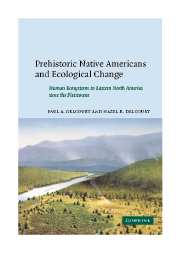 Prehistoric Native Americans and Ecological Change
Prehistoric Native Americans and Ecological Change PART II - ECOLOGICAL FEEDBACKS AND PROCESSES
Published online by Cambridge University Press: 30 October 2009
Summary
OVERVIEW
Complex ecological feedbacks between humans and their environment have taken place on many different spatial and temporal scales (Figure 3.4). To look at cycles of adaptation, organization, destabilization, and reorganization in their appropriate contexts (Figure 3.1) requires being able to slide back and forth in time and place, as relevant to the panarchical level of interest. In Part II, we summarize examples of prehistoric Native American ecosystem dynamics based on level of biological interaction, from genetic and population level to community, landscape, and regional level.
In Chapter 4, Gene-level interactions, we explore the ecological implications of the transition from foragers to farmers that occurred beginning in the Archaic cultural period. This transition in lifeways resulted in the addition of a panarchical level (Figure 3.5), and was characterized by a number of facilitative interactions among plants, their pollinators, their seed dispersers, and their harvesters. Incipient domestication of native plant species began by 4500 BP. In the process of becoming farmers, Archaic Native Americans developed mutualistic relationships with individual plant domesticates as they selected phenotypes of edible plants that showed the greatest robustness of seeds and fruits. With first domestication, genetic diversity was enhanced locally for squash, sunflower, maygrass, little barley, goosefoot, and marsh elder.
Chapter 5, Population-level interactions, explores the relationship between Archaic and Woodland people and their plant domesticates, as well as their animal prey.
- Type
- Chapter
- Information
- Prehistoric Native Americans and Ecological ChangeHuman Ecosystems in Eastern North America since the Pleistocene, pp. 33 - 35Publisher: Cambridge University PressPrint publication year: 2004


